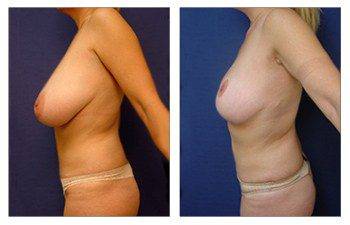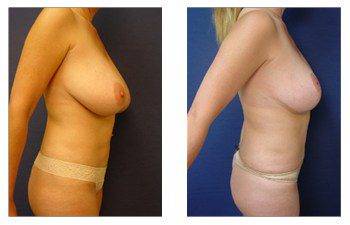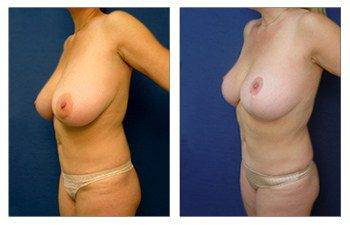




Download SurgiSculpt’s free Liposuction eBook
Introduction: How Does Breast Lift Work?
A mastopexy, or breast lift as it is commonly referred to, is a plastic surgery procedure that is typically cosmetic based. This procedure was created to correct the natural sagging of the breast skin and mound as well as the nipples that occur with aging. As we age, our skin gradually loses its elastic capacity to snap back into place after being stretched. A decrease in elasticity and the continued effects of gravity result in breast ptosis, otherwise known as sagging.
As a result of gravity and breast size, the breast mound and skin will begin to droop as you age. Patients with this contour irregularity look to cosmetic surgery since it can’t be corrected through breast augmentation alone. Many patients are consulted monthly desiring a breast lift procedure with breast implants. Unfortunately, patients must be explained that an increase in breast size alone is not capable of reversing breast sagging. Thus, the breast lift surgery was designed to excise this sagging skin and return you to your youthful breast appearance. In general, a breast lift works by removing all the excess sagging skin. In reality, there are several ways to perform a breast lift and although they may work the same way, their results may be drastically different.
One of the proposed breast lift techniques has been described as the donut lift. The reason for its initial popularity was its limited incision length. However, this technique has fallen out of favor since it results in a prominent scar due to its inability to spread the tension along its incision lines and more notably resulting in a suboptimal areola scar.
When people think of breast lifts, they often imagine the anchor incision, which describes a vertical incision line that merges with a semicircular horizontal incision. This is the traditional breast lift described as the Weiss pattern in the medical community. The advantage of this incision is that the tension is transferred away from the nipple and areola and onto the inframammary crease. As such, the nipple and areola incision are aesthetically superior and well-healed. The two disadvantages of the traditional breast lift is its transfer of undue weight on the bottom of the breast mound resulting in bottoming out. Further, it is not amenable to a simultaneous breast implant placement. As a result, we present the modified vertical breast lift that provides the ability to perform a breast lift with and without an implant. As such, let us dive deeper into the ins and outs of how breast lifts work.
Breast Lift Explained: The Comprehensive Guide to Mastopexy
The Allure of Youthful Contours
Breast lifts, or mastopexy, have emerged as a beacon of hope for countless women worldwide. As time progresses, factors such as aging, gravity, and significant life events like childbirth can lead to sagging breasts. Mastopexy seeks to reverse this natural progression, offering a rejuvenated silhouette and renewed self-confidence.
The Anatomy and Physiology of Breasts
Understanding Breast Composition
Breasts are intricate structures that play a pivotal role in a woman’s life, both functionally and aesthetically. Comprising fatty tissue, glandular tissue, connective tissue, and the overlying skin, the balance of these components determines the size, shape, and firmness of the breasts. Hormonal changes during menstruation, pregnancy, and menopause can influence this balance, leading to changes in breast texture and firmness.
Factors Influencing Breast Shape and Firmness
Several factors can influence the shape and firmness of breasts. Genetics plays a significant role, in determining the inherent structure and size of the breasts. Hormonal changes, especially during puberty, pregnancy, and menopause, can lead to fluctuations in breast size and firmness. Weight gain or loss can also impact breast shape, as can the natural aging process, which can cause the skin to lose its elasticity.
Mastopexy: Delving Deeper into the Procedure
The Philosophical Premise of a Breast Lift
At its core, a breast lift is about rejuvenation and transformation. It’s about restoring what time and life events have altered. But more than that, it’s about empowering women, allowing them to reclaim their bodies and, by extension, their self-confidence.
The Surgical Steps Involved
1. Anesthesia Administration: Ensuring patient comfort is paramount. Depending on the patient’s health, the surgeon’s recommendation, and the complexity of the procedure, either intravenous sedation or general anesthesia is administered.
2. Anesthesia Administration: Ensuring patient comfort is paramount. Depending on the patient’s health, the surgeon’s recommendation, and the complexity of the procedure, either intravenous sedation or general anesthesia is administered.
3. Breast Reshaping: This is the crux of the procedure. The underlying breast tissue is meticulously lifted and reshaped to enhance contour and firmness. The nipple and areola are repositioned to ensure they align with the new breast shape. If necessary, the areola size is reduced by excising excess skin. The removal of extra skin is crucial as it compensates for lost elasticity.
4. Closing the Incisions: Once the desired shape is achieved, the incisions are closed. Advanced techniques ensure that most scars are concealed within the natural contours of the breast. Over time, these scars fade, blending seamlessly with the surrounding skin.
Post-Operative Care, Recovery, and Long-Term Results
The Recovery Timeline
Recovery from a breast lift is a phased process. The initial phase involves managing swelling and discomfort, which are natural post-operative occurrences. Prescribed medications can alleviate these symptoms. Within a day, patients are usually mobile, and within a week, they can resume non-strenuous activities. However, it’s essential to avoid vigorous activities for at least six weeks post-surgery.
Ensuring Optimal Results
For results that stand the test of time, patients are advised to maintain a stable weight. Significant weight fluctuations can alter the shape and firmness of the breasts, potentially compromising the results of the surgery. A balanced diet, rich in vitamins and minerals, can aid in the healing process. Smoking is a known impediment to healing, so it’s crucial to avoid it both pre and post-surgery. Wearing supportive bras, especially during physical activities, can help maintain the shape and firmness of the breasts. Regular check-ups with the surgeon ensure that the healing process is on track and any potential complications are addressed promptly.
Potential Risks and How to Mitigate Them
Like all surgical procedures, breast lifts come with a set of potential risks. These include scarring, changes in breast or nipple sensation, asymmetry, and complications related to anesthesia. However, by choosing a board-certified surgeon with a stellar track record, many of these risks can be minimized. Post-operative care, as outlined by the surgeon, is crucial in preventing complications like infections and ensuring optimal healing.
The Psychological Impact of a Breast Lift
Beyond the physical transformation, a breast lift can have profound psychological benefits. For many women, sagging breasts can be a source of insecurity, impacting their self-esteem and body image. By restoring the youthful contour of their breasts, women often experience a surge in confidence. This renewed self-assuredness can permeate various aspects of their lives, from personal relationships to professional endeavors.
Conclusion: How Does a Breast lift Work
A breast lift, while primarily a cosmetic procedure, is also a journey of transformation. It’s about reclaiming one’s youthful spirit by rejuvenating your aging breast appearance.
See this 32-year-old patient who is only 1 month post-op. Her scar is only 40-60% healed, yet is already almost invisible by utilizing an anchor lift pattern. A breast lift, also known as mastopexy, is a surgical procedure used to reshape and raise sagging breasts. During the procedure, excess skin is removed, and the remaining tissue is tightened to lift the breasts higher on the chest. The type of incision used for a breast lift depends on various factors such as the size of your breasts, degree of sagging,
See this 32-year-old patient who is only 1-month post-op. Her scar is only 40-60% healed, yet is already almost invisible.
